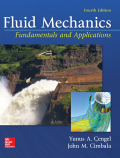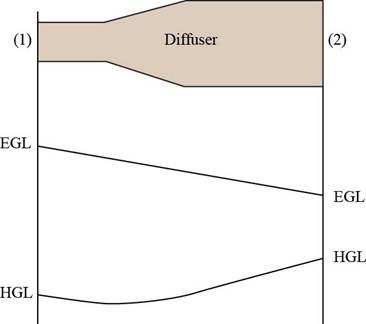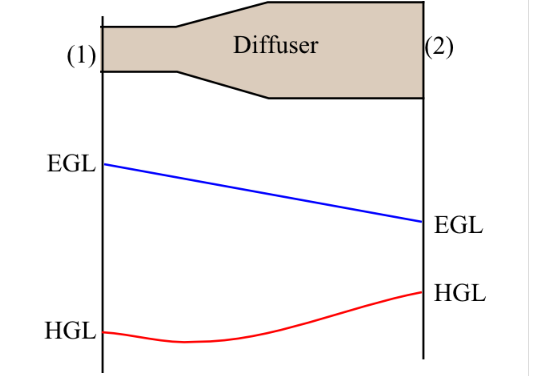
Concept explainers
A diffuser in a pipe flow is basically a slow expansion of the pipe diameter, which slows down the fluid velocity and increases the pressure (the Bernoulli effect). Water at room temperature flows with a volume flow rate of 00250 m3/s through a horizontal diffuser in which the pipe diameter increases gradually from D1= 6.00 to D2= 11.00 cm. The irreversible head loss through the diffuser is estimated to be 0.450 in. The flow is turbulent, and the kinetic energy correction factors at both the inlet and outlet of the diffuser are assumed to be 1.05.
(a) Calculate the pressure difference P2- P1in units of kPa using the energy equation.
(b) Repeat using the Bernoulli equation (ignore irreversible head losses and ignore kinetic energy correction factors-in other words, set the kinetic energy correction factors to 1). Calculate the percentage error in the result due to the Bernoulli approximation. and explain why (or why not) Bernoulli is applicable here.
(c) It may be surprising that the answer to part (a) is positive. i.e., the pressure rises downstream. How is this possible? Explain by calculating the change i n energy grade line EGL and the change in hydraulic grade line .HGL from the upstream to the downstream location. In particular, does EGL go up or down, and does HGL go up or down?
(a)
The pressure difference between outlet to inlet of diffuser.
Answer to Problem 116P
The pressure difference between outlet to inlet of diffuser is
Explanation of Solution
Given information:
The volume flow rate of diffuser is
Write the expression for area of pipe.
Here diameter of section is
Write the expression for velocity.
Here volume flow rate is
Consider inlet section as
Write the expression for energy equation in control volume.
Here, density is
Substitute
Calculation:
Substitute
Substitute
Substitute
Substitute
Refer to table "Properties of saturated water" to obtain density of water as
Substitute,
Conclusion:
The pressure difference between outlet to inlet of diffuser is
(b)
The pressure difference using Bernoulli equation.
The percent error due to Bernoulli approximation.
Answer to Problem 116P
The pressure difference using Bernoulli equation is
The percent error due to Bernoulli approximation is
Explanation of Solution
Given information:
Ignore irreversible head loss, kinetic energy correction factor
Write the expression for Bernoulli equation.
Write the expression for error percentage.
Here, pressure difference using energy equation is
Calculation:
Substitute
Substitute
Bernoulli equation is not applicable here because of pressure head loss and kinetic energy correction factor as greater
Conclusion:
The pressure difference using Bernoulli equation is
The percent error due to Bernoulli approximation is
(c)
The nature of Energy Grade line.
The nature of Hydraulic Grade line.
Answer to Problem 116P
The Energy Grade Line (EGL) decrease from the inlet to the exit and Energy grade Line goes down.
The Hydraulic Grade Line (HGL) increase from the inlet to the exit and Hydraulic grade Line goes up.

Figure-(1)
The Figure (1) shows the nature of Energy Grade Line (EGL) and Hydraulic Grade Line (HGL).
Explanation of Solution
Given information:
Write the expression for net Energy Grade Line (EGL).
Substitute
Write the expression for net Hydraulic Grade Line (HGL).
Substitute
Calculation:
Substitute
Substitute
Conclusion:
The Energy Grade Line (EGL) decrease from the inlet to the exit and Energy grade Line goes down.
The Hydraulic Grade Line (HGL) increase from the inlet to the exit and Hydraulic grade Line goes up.

Figure (1)
The Figure (1) shows the nature of Energy Grade Line and Hydraulic Grade Line.
Want to see more full solutions like this?
Chapter 5 Solutions
EBK FLUID MECHANICS: FUNDAMENTALS AND A
- Copyright 2013 Pearson Education, publishing as Prentice Hall 2. Determine the force that the jaws J of the metal cutters exert on the smooth cable C if 100-N forces are applied to the handles. The jaws are pinned at E and A, and D and B. There is also a pin at F. E 400 mm 15° D B 30 mm² 80 mm/ 20 mm 15° $15° 20 mm 400 mm 15° 100 N 100 N 15°arrow_forwardDraw for it make a match which directionarrow_forwardQ.1) Block A is connected to block B by a pulley system as shown. The weights of blocks A and B are 100 lbs and 70 lbs, respectively. Assume negligible friction between the rope and all pulleys as well as between block B and the incline and neglect the mass of all pulleys and cables. Determine the angle 0 required to keep the system in equilibrium. (At least two FBDs must be drawn for full credit) B Ꮎ 000arrow_forward
- pls solvearrow_forward+1. 0,63 fin r= 0.051 P The stepped rod in sketch is subjected to a tensile force that varies between 4000 and 7000 lb. The rod has a machined surface finish everywhere except the shoulder area, where a grinding operation has been performed to improve the fatigue resistance of the rod. Using a 99% probability of survival, determine the safety factor for infinite life if the rod is made of AISI 1080 steel, quenched and tempered at 800°c Use the Goodman line. Does the part fail at the fillet? Explainarrow_forwardSolve this problem and show all of the workarrow_forward
- I need drawing solution,draw each one by one no Aiarrow_forwardQu. 17 Compute linear density values for [100] for silver (Ag). Express your answer in nm''. . Round off the answer to three significant figures. Qu. 18 Compute linear density value for [111] direction for silver (Ag). Express your answer in nm'. Round off the answer to three significant figures. Qu. 19 Compute planar density value for (100) plane for chromium (Cr). Express your answer in nm?. Round off the answer to two significant figures. Qu. 20 Compute planar density value for (110) plane for chromium (Cr). Express your answer in nm ≥ to four significant figures. show all work please in material engineeringarrow_forward3-142arrow_forward
 Elements Of ElectromagneticsMechanical EngineeringISBN:9780190698614Author:Sadiku, Matthew N. O.Publisher:Oxford University Press
Elements Of ElectromagneticsMechanical EngineeringISBN:9780190698614Author:Sadiku, Matthew N. O.Publisher:Oxford University Press Mechanics of Materials (10th Edition)Mechanical EngineeringISBN:9780134319650Author:Russell C. HibbelerPublisher:PEARSON
Mechanics of Materials (10th Edition)Mechanical EngineeringISBN:9780134319650Author:Russell C. HibbelerPublisher:PEARSON Thermodynamics: An Engineering ApproachMechanical EngineeringISBN:9781259822674Author:Yunus A. Cengel Dr., Michael A. BolesPublisher:McGraw-Hill Education
Thermodynamics: An Engineering ApproachMechanical EngineeringISBN:9781259822674Author:Yunus A. Cengel Dr., Michael A. BolesPublisher:McGraw-Hill Education Control Systems EngineeringMechanical EngineeringISBN:9781118170519Author:Norman S. NisePublisher:WILEY
Control Systems EngineeringMechanical EngineeringISBN:9781118170519Author:Norman S. NisePublisher:WILEY Mechanics of Materials (MindTap Course List)Mechanical EngineeringISBN:9781337093347Author:Barry J. Goodno, James M. GerePublisher:Cengage Learning
Mechanics of Materials (MindTap Course List)Mechanical EngineeringISBN:9781337093347Author:Barry J. Goodno, James M. GerePublisher:Cengage Learning Engineering Mechanics: StaticsMechanical EngineeringISBN:9781118807330Author:James L. Meriam, L. G. Kraige, J. N. BoltonPublisher:WILEY
Engineering Mechanics: StaticsMechanical EngineeringISBN:9781118807330Author:James L. Meriam, L. G. Kraige, J. N. BoltonPublisher:WILEY





